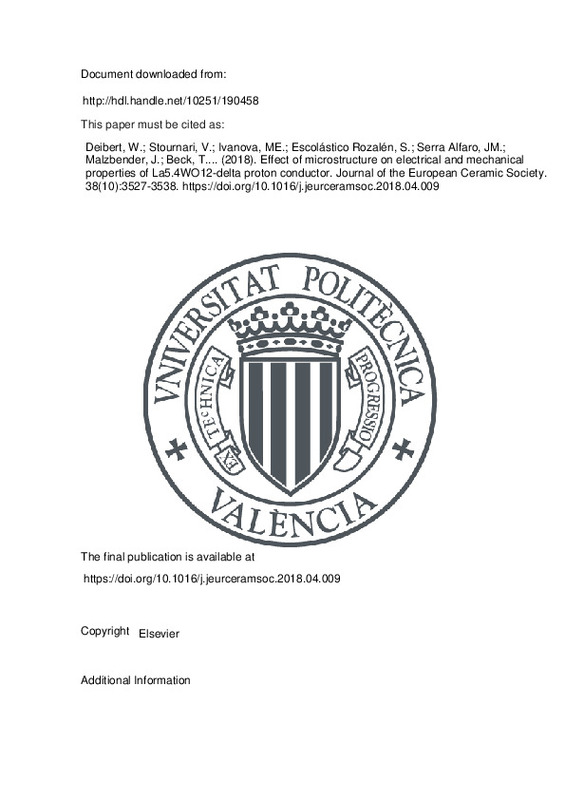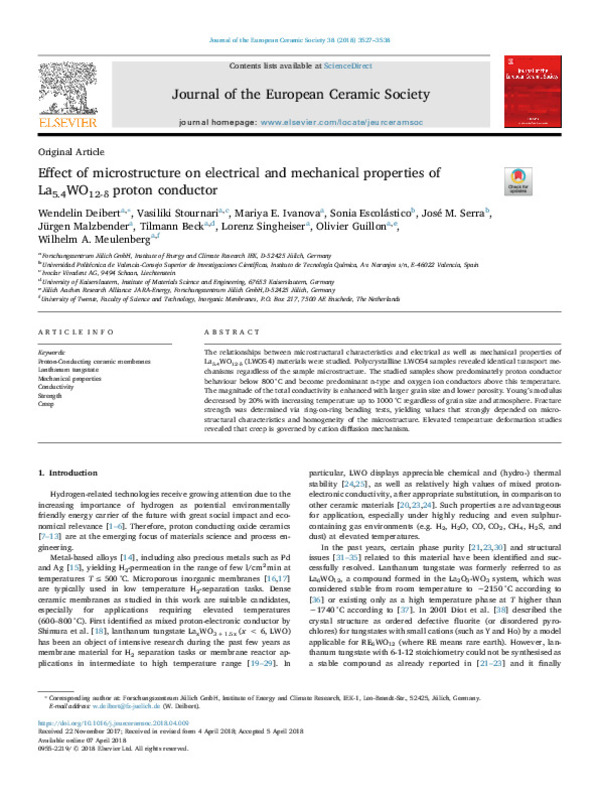JavaScript is disabled for your browser. Some features of this site may not work without it.
Buscar en RiuNet
Listar
Mi cuenta
Estadísticas
Ayuda RiuNet
Admin. UPV
Effect of microstructure on electrical and mechanical properties of La5.4WO12-delta proton conductor
Mostrar el registro sencillo del ítem
Ficheros en el ítem
| dc.contributor.author | Deibert, Wendelin
|
es_ES |
| dc.contributor.author | Stournari, Vasiliki
|
es_ES |
| dc.contributor.author | Ivanova, Mariya E.
|
es_ES |
| dc.contributor.author | Escolástico Rozalén, Sonia
|
es_ES |
| dc.contributor.author | Serra Alfaro, José Manuel
|
es_ES |
| dc.contributor.author | Malzbender, Juergen
|
es_ES |
| dc.contributor.author | Beck, Tilman
|
es_ES |
| dc.contributor.author | Singheiser, Lorenz
|
es_ES |
| dc.contributor.author | Guillon, Olivier
|
es_ES |
| dc.contributor.author | Meulenberg, Wilhelm A.
|
es_ES |
| dc.date.accessioned | 2022-12-01T19:01:08Z | |
| dc.date.available | 2022-12-01T19:01:08Z | |
| dc.date.issued | 2018-08 | es_ES |
| dc.identifier.issn | 0955-2219 | es_ES |
| dc.identifier.uri | http://hdl.handle.net/10251/190458 | |
| dc.description.abstract | [EN] The relationships between microstructural characteristics and electrical as well as mechanical properties of La5.4WO12-delta (LWO54) materials were studied. Polycrystalline LWO54 samples revealed identical transport mechanisms regardless of the sample microstructure. The studied samples show predominately proton conductor behaviour below 800 degrees C and become predominant n-type and oxygen ion conductors above this temperature. The magnitude of the total conductivity is enhanced with larger grain size and lower porosity. Young's modulus decreased by 20% with increasing temperature up to 1000 degrees C regardless of grain size and atmosphere. Fracture strength was determined via ring-on-nng bending tests, yielding values that strongly depended on microstructural characteristics and homogeneity of the microstructure. Elevated temperature deformation studies revealed that creep is governed by cation diffusion mechanism. | es_ES |
| dc.description.sponsorship | This work was conducted thanks to the financial support by the Helmholtz Association, Initiative and Networking Fund, MEM-BRAIN Portfolio and POFIII. The colleagues from ZEA-3 are acknowledged for performing the ICP-OES analysis. We would like to thank Ms. Tatjana Osipova for the mechanical testing and Dr. Egbert Wessel for the SEM studies | es_ES |
| dc.language | Inglés | es_ES |
| dc.publisher | Elsevier | es_ES |
| dc.relation.ispartof | Journal of the European Ceramic Society | es_ES |
| dc.rights | Reconocimiento - No comercial - Sin obra derivada (by-nc-nd) | es_ES |
| dc.subject | Proton-Conducting ceramic membranes | es_ES |
| dc.subject | Lanthanum tungstate | es_ES |
| dc.subject | Mechanical properties | es_ES |
| dc.subject | Conductivity | es_ES |
| dc.subject | Strength | es_ES |
| dc.subject | Creep | es_ES |
| dc.title | Effect of microstructure on electrical and mechanical properties of La5.4WO12-delta proton conductor | es_ES |
| dc.type | Artículo | es_ES |
| dc.identifier.doi | 10.1016/j.jeurceramsoc.2018.04.009 | es_ES |
| dc.rights.accessRights | Abierto | es_ES |
| dc.contributor.affiliation | Universitat Politècnica de València. Instituto Universitario Mixto de Tecnología Química - Institut Universitari Mixt de Tecnologia Química | es_ES |
| dc.description.bibliographicCitation | Deibert, W.; Stournari, V.; Ivanova, ME.; Escolástico Rozalén, S.; Serra Alfaro, JM.; Malzbender, J.; Beck, T.... (2018). Effect of microstructure on electrical and mechanical properties of La5.4WO12-delta proton conductor. Journal of the European Ceramic Society. 38(10):3527-3538. https://doi.org/10.1016/j.jeurceramsoc.2018.04.009 | es_ES |
| dc.description.accrualMethod | S | es_ES |
| dc.relation.publisherversion | https://doi.org/10.1016/j.jeurceramsoc.2018.04.009 | es_ES |
| dc.description.upvformatpinicio | 3527 | es_ES |
| dc.description.upvformatpfin | 3538 | es_ES |
| dc.type.version | info:eu-repo/semantics/publishedVersion | es_ES |
| dc.description.volume | 38 | es_ES |
| dc.description.issue | 10 | es_ES |
| dc.relation.pasarela | S\360065 | es_ES |









